#sustainable gardening
Text

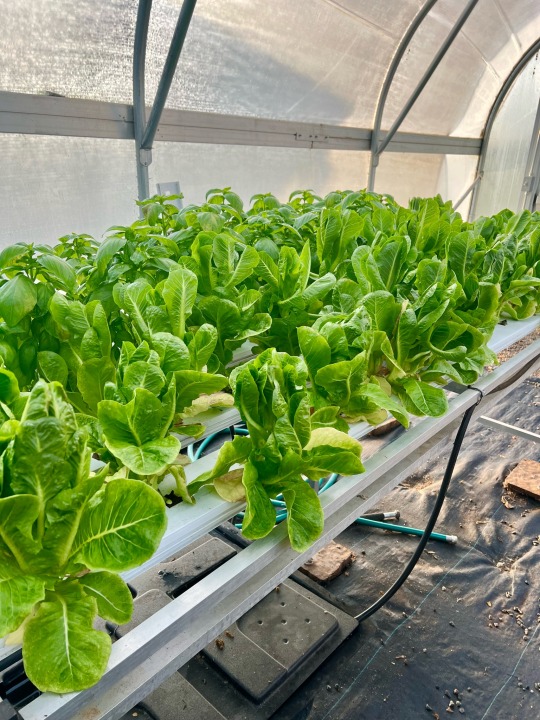
9/19/23 ~ Hydroponics at school. Those cucumbers grew super fast 😳 and some Romaine Lettuce!
#indoor garden#container gardening#sustainable gardening#vegetable gardening#starting seeds#grow organic#grow your own food#organic gardening#tomato garden#green witch#greenhouse#greenhouse nursery#plant nursery#hydroponics#growing cucumbers#romaine lettuce#sustainable agriculture
56 notes
·
View notes
Text
Today at work I was listening to gardening podcast, and it stopped me in my tracks because one of the hosts said that gardening in containers was inherently unsustainable, because you have to water them so much more.
Now, obviously I disagree, and I think it's unnecessarily discouraging for folks who for one reason or another are limited to growing in containers.
There are so many ways to address this, and perhaps the easiest (if you're growing ornamentals) is to grow drought tolerant species so that they won't be bothered by less water than in-ground plants. In fact, this can be a solution if you live somewhere with moist soils but want to grow things that like dryer soil.
Next, if you have drainage holes and put pots on the soil surface, roots WILL eventually root down into the soil. You can cut the bottom off pots or enlarge the holes to encourage this. I keep plants that like to spread (such as mints) in pots like these, and I don't water them. Because I believe in making plants find their own water, in general.
Next, if you want to grow more water thirsty plants, then look into reusing water. For example, a lot of people wash their rice or rinse their beans- you can water with that.
Do you wash your veggies? Water with that.
If you hand wash dishes, you can wash in a dish pan and then water with that (put the chunks in the compost though).
You know how they say to catch the water from when your shower is warming up? Water with that.
Use a dehumidifier or a/c unit that collects water? Water with that!
Get a rain barrel (or more than one) & water with that!
#gardenblr#gardening#container gardening#sustainable living#sustainable gardening#grow your own#indoor garden#garden#edible gardening
861 notes
·
View notes
Text
Started a new no-till garden bed, and it's definitely not my usual style because it's very late in the year for starting a new bed, but I just got access to the area, so needs must.
First step was to cut down all the weeds:


Then I loosened the soil in a few spots where I'll be transplanting some tomatoes, cycurbits, and beans, and then covered them with upside-down pots as place holders. The step after that was to spread all the weeds I had cut down to act as a mulch:

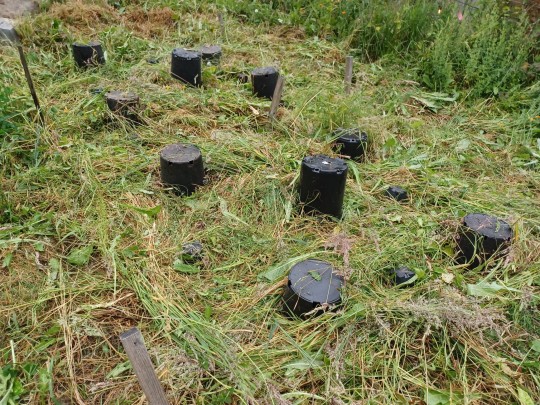
Finally, I covered everything with a layer of wood chips:
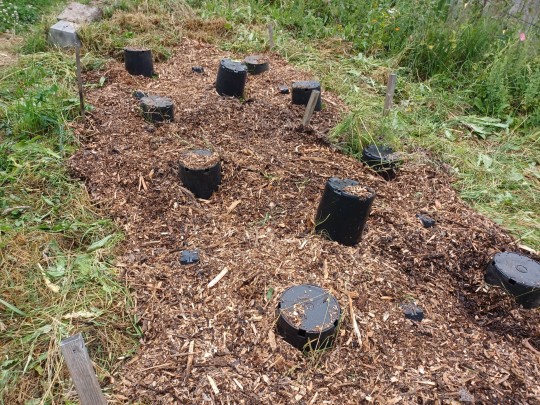
The idea here is to disturb the soil mycelium and bacteria communities as little as possible, while giving the transplants a chance to get established. The cut weeds will decompose and feed the crops, and the woods chips act as another layer of mulch, helping to both shade out the weeds and retain soil moisture.
17 notes
·
View notes
Text
Seed starting, mid-April edition
I really like the concept of no-till gardening. I really do. The invasive bindweed in my garden makes it an impossibility, unfortunately.
So this morning, I went and pulled out all the bindweed I could out of a nine square foot area (about a square meter), put a small pile of wood chips to serve as a stepping spot in the middle, added about 2 gallons of homemade compost, sowed a mix of seeds, watered it in, and topped it off with a very fine mulch.
The mix is an eclectic combination of lettuce, spinach, arugula, amaranth, Nigella, cosmos, cilantro, green onions, marigolds, sweet allysum, mustard greens, melons, and cucumbers. If you've heard of a milpa or chaos gardening, that's kinda the idea. The weather is going to be unpredictable this year, and given that I know bind weed will be coming back, I don't feel like trying for careful spacing of particular crops. Instead, I'm sure something of that mix will be happy with what ever mix of water and sun it gets. And it's dense enough that it should do a good job of out competing the weed seedlings that would like to come up.
#April sowing 1#chaos gardening#vegetable gardening#permaculture#sustainable gardening#frugal gardening
2 notes
·
View notes
Text
Unveiling the Desert's Charm: Growing Penstemons and Wildflowers in Queen Creek, Arizona
Transforming Arid Landscapes into Blossoming Gardens
In the heart of the Sonoran Desert, amidst the dry, rugged landscape of Queen Creek, Arizona, lies the potential for a blooming oasis. The key to this transformation? A brilliant array of penstemons and native wildflowers. This article will guide you through selecting the best penstemons for the low desert and companion wildflowers to create a…
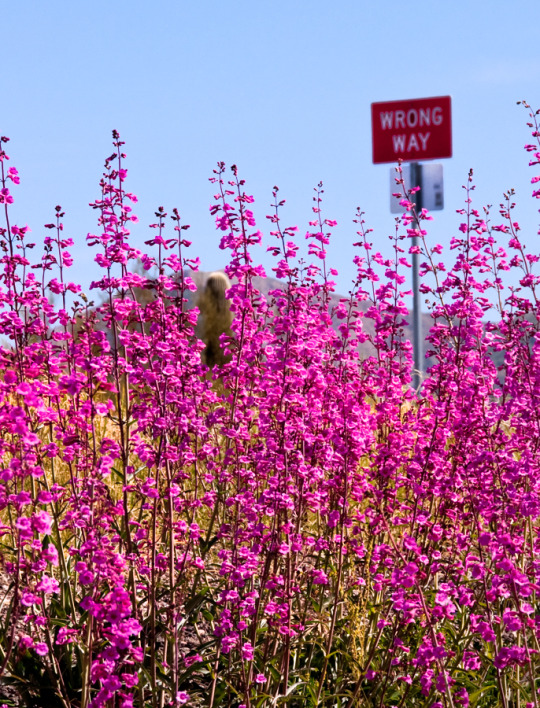
View On WordPress
#Desert Beardtongue#desert gardening#Desert Landscaping#Drought-Tolerant Plants#Eco-Friendly Gardening#Firecracker Penstemon#Garden Design#Growing Wildflowers#Hummingbird-Friendly Gardening#Native Plants#Penstemon Cultivation#Penstemon eatonii#Penstemon parryi#Penstemon pseudospectabilis#Pollinator Gardens#Queen Creek Arizona#Seed Germination#Sustainable Gardening#Xeriscaping
4 notes
·
View notes
Text
How to grow vegetables in 6 simple steps?

Don't know where to start with your own vegetable garden? Check out our new infographic on How to grow vegetables in 6 simple steps! From selecting the right seeds to harvesting your bounty, our easy-to-follow guide will have you growing your own fresh produce in no time.
Visit www.yardener.com for more gardening resources.
Want more gardening resources? Check here
#Vegetable gardening#Gardening tips#Growing vegetables#Step-by-step gardening#Home gardening#Vegetable cultivation#Gardening for beginners#Organic gardening#Planting vegetables#Vegetable garden care#Gardening techniques#Growing your own food#Vegetable gardening guide#Sustainable gardening#Garden planning#Soil preparation#Free Gardening Information#Pest control in gardens#Yardener#Garden maintenance
3 notes
·
View notes
Text
"There is a 10,000-plus-year history of deep seed-people relationships that have largely been broken in the last few hundred years of industrialization and the last few decades of corporate genetic modification."
Mostly for my personal reference but a wonderful read if anyone wants to and can.
#gardening#seeds#seed savers#agriculture#sustainable agriculture#sustainable gardening#i like how the author mixed the seeds that did the best with the unexpected frost to breed hardier plants for the changing climate
2 notes
·
View notes
Text
My biggest flex is that strawberries are native to where I live can I could technically seed bomb w/ strawberry plants.
I could also just garden them normally tbh, but living in an apartment can make that difficult lmao
13 notes
·
View notes
Text
50 Zero Waste Tips Passed Down By Your Grandparents

View On WordPress
#community sharing#eco-conscious living#eco-friendly practices#food preservation#organic practices#sustainable fashion#sustainable gardening#sustainable household items#sustainable kitchen#sustainable mindset#timeless clothing#zero waste cooking#zero waste lifestyle#zero waste outdoors#zero waste wardrobe
2 notes
·
View notes
Text
I'm really excited about this garden, because while I grew up on a small organic farm, I've learned a lot in the years since I left home. A lot about mycorrhizae, soil bacteria, interplanting, insectary plants, and passive water catchment techniques, and I'm really excited to try them on a bigger scale than my back yard.
So let's look at a few of the design guidelines I have for this place.
1. Use practices that encourage mycorrhizae & other soil microbiota. In practice, this means we will not dig in the soil if at all possible, we will keep the soil covered with mulches (including living mulches), and we will keep healthy roots in the soil year round (either by having a living mulch or biennial & perennial crops). We will also not be using concentrated forms of fertilizer, such as inorganic, bone meal, guano, etc, as these have been shown to disrupt the relationship between plants & mycorrhizae.
2. With few exceptions, crops will be inter-planted, usually with plants that have been shown to reduce damage to crops, improve the health of the crops, fix nitrogen, or support native insect species.
3. There will be a lot of insectary plants, and large areas for native plants to grow. We will encourage species that support native pollenators & birds, discourage invasive species, and work to make sure our garden benefits the surrounding ecosystem. We will not be using pesticides, herbicides, or inorganic fertilizers.
4. We will be using passive rainwater catchment practices to retain as much soil moisture as possible and reduce irrigation as much as possible. This will look like the use of mulches, incorporating as much organic matter as possible, and possibly the construction of swales.
If you want some resources on these matters, here's a reading list, ranging from memoirs with good info to books with many case studies
The One-Straw Revolution: An Introduction to Natural Farming, by Masanobu Fukuoka
The Ruth Stout No Work Garden Book, by, you guessed it, Ruth Stout
The Complete Guide to Restoring Your Soil, by Dale Strickler
Finding the Mother Tree, by Suzanne Simard
Mycelium Running, Paul Stamets
#gardening#organic gardening#permaculture#save the bees#sustainable gardening#mycorrhizae#no till#no dig#tiny farm
14 notes
·
View notes
Text

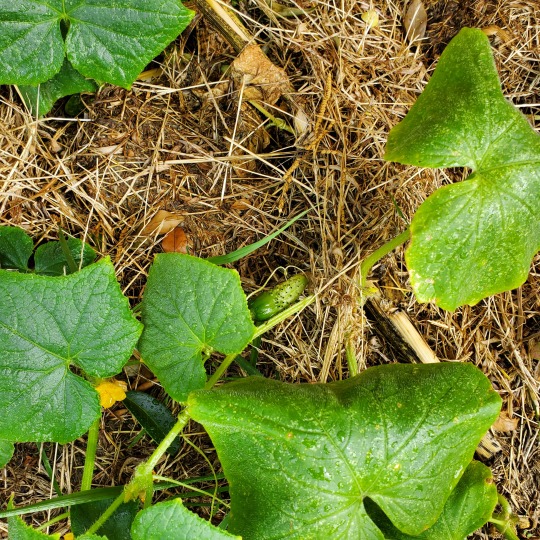



growing cucumbers is fun because it kind of looks like a bunch of dinosaur eggs spawned in my yard.
anyway i love them and would die for them.
4 notes
·
View notes
Text

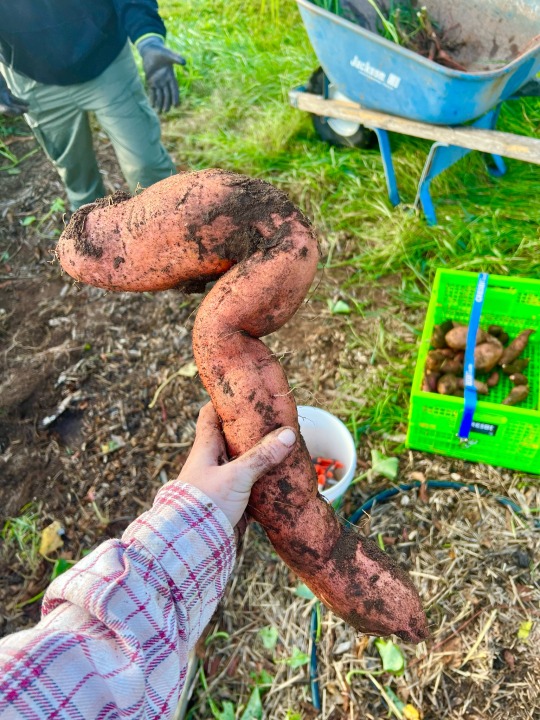
9/19/23 ~ Sweet Potato harvest at school today. Some of these suckers were HUGE! I took home a lot.
Recipes to come 😇
#indoor garden#container gardening#sustainable gardening#vegetable gardening#starting seeds#grow organic#grow your own food#organic gardening#tomato garden#green witch#sweet potato#potato garden#harvest season#harvesting#vegetarian#veganuary#sustainable agriculture
30 notes
·
View notes
Text

It's that time!
I'm trying out peppers, both bell & paprika. Usually, our summers are too cool for them, but the last 3 have been quite hot, and it's supposed to switch to an El niño in August. So I am feeling pretty confident that we'll have another hot year, given NOAA's long term prediction for the summer months:
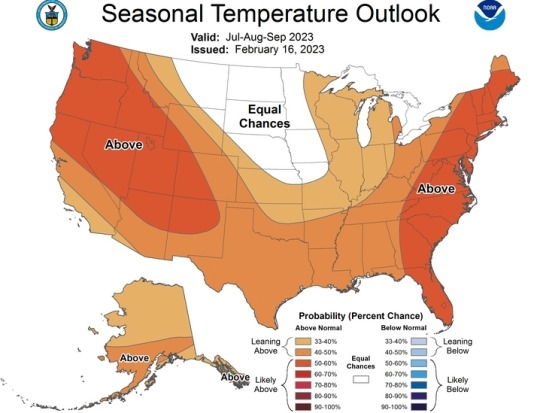
Note that that's a probability map, not temperature.
These guys are in my seed starting mix, which is about equal portions of homemade compost, coconut coir, and perlite, and they're growing indoors under lights. They'll stay inside until night time temperatures stay above 50f. When it's time to pot up, some of them will continue as is, and some will get soil mixed with the garden plot, to hopefully inoculate them with the native mycorrhizae, and some will get inoculated with store bought mycorrhizae. It'll be interesting to see what, if any, differences will appear.
#gardenblr#seed starting#sustainable gardening#because this is like#the 3rd round for those pots#and i got them out of a free pile#:D
21 notes
·
View notes
Text
This makes some of the practices we'll be implementing, and I'm glad to see them getting more attention.
3 notes
·
View notes
Text
How to Grow Hydroponic Basil for Beginners
Embarking on the journey of hydroponic gardening opens a door to a world where the art of cultivation meets innovation. Among the myriad choices for your first hydroponic endeavor, basil stands as a welcoming companion for beginners. It’s aromatic leaves and versatile nature make it an ideal choice to explore the wonders of soil-less growing. Whether you have a spacious garden or a modest…

View On WordPress
#Basil care#Basil varieties#Beginner hydroponics#Fresh culinary herbs#Herb gardening#Homegrown herbs#Hydroponic basil#Hydroponic nutrients#Hydroponic systems#indoor gardening#Nutrient solutions#Soil-less cultivation#Sustainable Gardening#Urban Gardening
2 notes
·
View notes
Text
How to create a summer garden that attracts pollinators
Are you wondering how to create a summer garden that attracts pollinators? 🌻🐝 Check out our infographic with simple steps to get started! Save it, share it, and use it to transform your garden into a pollinator paradise.

Looking for more resources on gardening? Head over to www.yardener.com and browse our collection of resources. We update regularly, so be sure to save our website for future reference. We offer a variety of content, including infographics, articles, and tips to help you create a thriving garden ecosystem. Check it out today!
#Attract Pollinators#Summer garden#Attracting bees#Sustainable gardening#Flowering plants#Habitat restoration#Garden design#Butterfly garden#Hummingbirds#Insect-friendly#Organic gardening#Plant diversity#Ecosystem health#Perennials#gardening free resources#gardening resources#gardening information’s#gardening informative website#gardening free care guide#gardening everything
3 notes
·
View notes